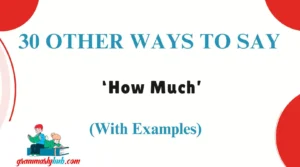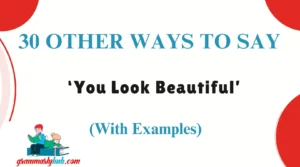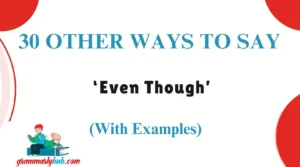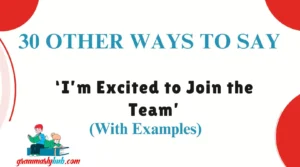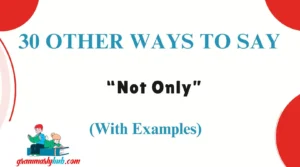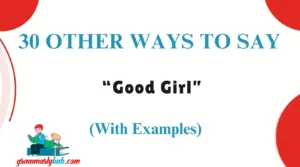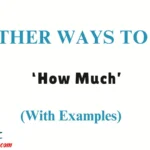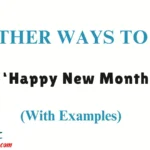In a world that’s constantly buzzing with communication, how we offer our support matters. A simple phrase like “Happy to help” can express kindness, generosity, and a willingness to assist—but sometimes, we want to say it in a way that feels more genuine, personal, or tailored to the situation.
Whether you’re writing an email, replying to a compliment, or wrapping up a helpful gesture, finding the right phrase adds a layer of warmth and thoughtfulness that makes your message stand out.
In this guide, you’ll discover 30 other meaningful, friendly, and professional ways to say “Happy to help”, complete with tone, usage, and examples—so your words always reflect the care behind your actions.
What Does “Happy to Help” Mean?
“Happy to help” is a polite, friendly expression used to let someone know you were glad to assist them. It communicates willingness, kindness, and a positive attitude, usually in response to someone saying “thank you” or acknowledging your support.
When to Use “Happy to Help”
You can use “Happy to help” in professional settings (like emails or customer service) or personal conversations. It’s often used:
- After completing a favor
- In follow-ups
- In customer support responses
- When offering further assistance
It’s suitable in both spoken and written formats and works across casual and formal tones.
Is It Professional/Polite to Say “Happy to Help”?
Yes, it’s both professional and polite. It’s a warm phrase that shows you’re approachable and willing, making it ideal for workplace emails, client communication, and daily conversation.
Pros and Cons of Saying “Happy to Help”
Pros:
- Warm and friendly
- Universally understood
- Appropriate in professional and casual contexts
Cons:
- May sound scripted or generic in overuse
- Lacks emotional depth in some personal situations
- Can seem impersonal if tone isn’t warm
Synonyms For “Happy to Help”
- Glad I Could Help
- Always Here for You
- Anytime!
- It Was My Pleasure
- Don’t Mention It
- No Problem at All
- I’ve Got You Covered
- At Your Service
- You Can Count on Me
- Just Doing My Part
- Anything for You
- More Than Willing
- It’s the Least I Could Do
- With Pleasure
- That’s What I’m Here For
- I’m on It
- I’ll Take Care of It
- You’re Welcome Anytime
- My Door Is Always Open
- Glad to Be of Service
- No Trouble at All
- I’m Just a Call Away
- It’s All Good
- I Was Happy to Do It
- I’m Grateful to Contribute
- Always Happy to Support
- Let Me Know If You Need Anything Else
- Don’t Hesitate to Ask
- I’ve Got Your Back
- Let’s Tackle It Together
1. Glad I Could Help
Definition: A polite way to express that you’re satisfied you could assist someone.
Explanation: This phrase acknowledges the help you provided while staying humble and friendly.
Scenario Example: “Thanks for reviewing my presentation slides!” “Glad I could help!”
Worst Use: Avoid in situations where the task was incomplete or unsuccessful—it may sound dismissive.
Tone: Warm, casual, and supportive.
2. Always Here for You
Definition: Shows emotional and practical support.
Explanation: Often used in more personal or empathetic contexts to offer continued presence.
Scenario Example: “I’m struggling this week.” “I’m always here for you.”
Worst Use: Avoid in strict professional settings—it can be too personal or emotional.
Tone: Empathetic, comforting, sincere.
3. Anytime!
Definition: Short and enthusiastic expression of availability.
Explanation: It implies you’re open to helping again in the future—quick, breezy, and upbeat.
Scenario Example: “Thanks for helping me move that box.” “Anytime!”
Worst Use: Avoid when the task was a burden—you might sound insincere.
Tone: Casual, cheerful, light-hearted.
4. It Was My Pleasure
Definition: Polite and gracious acknowledgment of your willingness to help.
Explanation: Ideal for formal situations, this phrase adds elegance and warmth.
Scenario Example: “Thank you for hosting us!” “It was my pleasure.”
Worst Use: Avoid when the experience wasn’t enjoyable—this could come across as fake.
Tone: Formal, gracious, polished.
5. Don’t Mention It
Definition: Dismisses the need for thanks by showing humility.
Explanation: Used to downplay your efforts and keep the focus on the other person’s comfort.
Scenario Example: “Thanks for covering my shift!” “Don’t mention it.”
Worst Use: Avoid with someone who might feel dismissed or undervalued.
Tone: Casual, humble, friendly
6. No Problem at All
Definition: A casual way of saying the help didn’t inconvenience you.
Explanation: This phrase implies the task was easy or unbothersome. It’s frequently used in everyday conversation and light professional settings.
Scenario Example: “Thanks for your quick reply!” “No problem at all!”
Worst Use: Avoid when someone has made a significant request—might sound too casual or dismissive.
Tone: Relaxed, friendly, informal.
7. I’ve Got You Covered
Definition: Means you’re handling the situation for someone.
Explanation: It reassures the other person they can rely on you, often used in both emotional and logistical support contexts.
Scenario Example: “I’m running late for the meeting.” “Don’t worry, I’ve got you covered.”
Worst Use: Avoid if you can’t fully take responsibility—this phrase implies total control.
Tone: Supportive, confident, dependable.
8. At Your Service
Definition: A courteous expression indicating you’re ready and willing to help.
Explanation: Often used in hospitality or customer service, it signals full availability and politeness.
Scenario Example: “Thanks for delivering that so quickly.” “At your service.”
Worst Use: Avoid in overly casual conversations—it may sound too formal or theatrical.
Tone: Professional, courteous, formal.
9. You Can Count on Me
Definition: Expresses reliability and personal commitment.
Explanation: This phrase is stronger than others—it assures the person that you’re a consistent support figure.
Scenario Example: “I might need help managing the schedule.” “You can count on me.”
Worst Use: Avoid if you’re unsure you can follow through—it sets a high expectation.
Tone: Reassuring, loyal, caring.
10. Just Doing My Part
Definition: A humble way to express that your help is simply a contribution to something bigger.
Explanation: It suggests teamwork and doesn’t boast about the help provided—ideal for collaborative environments.
Scenario Example: “Thanks for your input on the group project!” “Just doing my part.”
Worst Use: Avoid in deeply personal or emotional situations—it can sound too detached.
Tone: Modest, team-focused, humble.
11. Anything for You
Definition: A personal, affectionate way of expressing a willingness to help.
Explanation: Often used in close relationships, it emphasizes emotional warmth and willingness.
Scenario Example: “Can you pick me up after work?” “Of course—anything for you.”
Worst Use: Avoid in professional settings—it can sound overly emotional or romantic.
Tone: Caring, affectionate, sincere.
12. More Than Willing
Definition: Emphasizes eagerness or enthusiasm to assist.
Explanation: It strengthens the typical “willing to help” by adding a positive intensity, good for both formal and informal settings.
Scenario Example: “Thanks for proofreading my essay.” “I was more than willing.”
Worst Use: Avoid when offering minimal help—it might sound exaggerated.
Tone: Eager, positive, generous.
13. It’s the Least I Could Do
Definition: A modest phrase that downplays your help to elevate the other person’s value.
Explanation: This often follows a heartfelt thank you. It subtly communicates gratitude for the opportunity to assist.
Scenario Example: “You really went out of your way for me.” “It’s the least I could do.”
Worst Use: Avoid when your support was actually minimal—it may come off as sarcastic.
Tone: Modest, gracious, heartfelt.
14. With Pleasure
Definition: An elegant way to say you were happy to help.
Explanation: Similar to “my pleasure,” but slightly more refined. Great for thank-you responses in formal conversations.
Scenario Example: “Thanks for helping set up the event.” “With pleasure.”
Worst Use: Avoid in casual or sarcastic tones—it can sound insincere.
Tone: Elegant, sincere, warm.
15. That’s What I’m Here For
Definition: Conveys purpose and reassurance in offering help.
Explanation: It shows you see helping others as part of your role, whether in personal, team, or service-oriented contexts.
Scenario Example: “Thanks for explaining that!” “That’s what I’m here for.”
Worst Use: Avoid when help wasn’t expected or asked for—it might sound presumptive.
Tone: Supportive, intentional, dependable.
16. I’m on It
Definition: Quick acknowledgment that you’re taking care of something.
Explanation: Used often in work or action-oriented tasks to communicate speed and initiative.
Scenario Example: “Can you send that file today?” “Absolutely—I’m on it.”
Worst Use: Avoid when you’re unsure or delayed—it sets a fast expectation.
Tone: Direct, efficient, energetic.
17. I’ll Take Care of It
Definition: Signals accountability and assurance.
Explanation: This is proactive, showing the person they don’t need to worry any further.
Scenario Example: “Someone needs to handle this issue.” “Don’t worry—I’ll take care of it.”
Worst Use: Avoid using when unsure about solving the issue—it implies full responsibility.
Tone: Responsible, confident, assuring.
18. You’re Welcome Anytime
Definition: An inviting, ongoing offer of help or support.
Explanation: Goes beyond the one-time act of helping—it leaves the door open for future assistance.
Scenario Example: “Thanks for letting me drop by.” “You’re welcome anytime.”
Worst Use: Avoid with people you’re not actually willing to help again—it may feel fake.
Tone: Warm, open, genuine.
19. My Door Is Always Open
Definition: A metaphor indicating ongoing availability and openness.
Explanation: Ideal for leaders, managers, or anyone offering emotional or practical support regularly.
Scenario Example: “I’m having trouble with my new role.” “My door is always open.”
Worst Use: Avoid saying this if you’re not truly accessible—it can feel like a broken promise.
Tone: Inviting, approachable, empathetic.
20. Glad to Be of Service
Definition: A professional way to say you were happy to help.
Explanation: Frequently used in customer service, but can also fit formal or workplace environments.
Scenario Example: “Thanks for your prompt response.” “Glad to be of service.”
Worst Use: Avoid using sarcastically—it needs a sincere tone to feel authentic.
Tone: Professional, respectful, courteous..
21. No Trouble at All
Definition: Indicates the task caused no difficulty or inconvenience.
Explanation: This phrase helps minimize the perceived burden of helping. It’s gentle and assures the other person that they weren’t a bother.
Scenario Example: “I’m so sorry to ask again!” “No trouble at all—really.”
Worst Use: Avoid if the task actually was difficult—can feel dishonest or passive-aggressive.
Tone: Reassuring, kind, informal.
22. I’m Just a Call Away
Definition: A friendly way of letting someone know you’re always reachable.
Explanation: This phrase provides emotional comfort and reinforces your availability. It works well in both personal and casual professional relationships.
Scenario Example: “Thanks for helping me process everything.” “Of course. I’m just a call away.”
Worst Use: Avoid if you can’t truly offer ongoing support—expectations may be misaligned.
Tone: Warm, dependable, emotionally supportive.
23. It’s All Good
Definition: An easygoing way to reassure someone that things are fine and you’re not upset.
Explanation: Often used in casual contexts, it implies that whatever help was needed didn’t cause stress or bother.
Scenario Example: “Sorry for making extra work.” “No worries—it’s all good.”
Worst Use: Avoid in professional environments—it can sound too informal or dismissive.
Tone: Chill, laid-back, reassuring.
24. I Was Happy to Do It
Definition: Emphasizes that helping brought you joy or satisfaction.
Explanation: This phrase makes your generosity feel more intentional and heartfelt, especially after someone thanks you.
Scenario Example: “I appreciate everything you did for me.” “I was happy to do it.”
Worst Use: Avoid using when the effort was reluctant—it could feel insincere.
Tone: Genuine, kind, appreciative.
25. I’m Grateful to Contribute
Definition: Expresses thankfulness for being able to support or participate.
Explanation: This turns the focus from helping to appreciation—great for collaborative environments or acts of service.
Scenario Example: “Thanks for lending your skills to this project.” “I’m grateful to contribute.”
Worst Use: Avoid when your involvement was minimal—it might feel performative.
Tone: Humble, grateful, collaborative.
26. Always Happy to Support
Definition: Reinforces ongoing willingness to help in any way.
Explanation: This is perfect for long-term relationships, partnerships, or recurring collaborations where continued support is welcomed.
Scenario Example: “Thanks for helping out again this week.” “Always happy to support.”
Worst Use: Avoid if support is limited or has constraints—could mislead expectations.
Tone: Reliable, thoughtful, continuous.
27. Let Me Know If You Need Anything Else
Definition: An invitation for ongoing communication and further assistance.
Explanation: It keeps the door open for more support without being overbearing. It’s helpful in customer service, teams, or caring conversations.
Scenario Example: “Thanks for the info!” “Anytime—let me know if you need anything else.”
Worst Use: Avoid if you’re closing communication or not truly available.
Tone: Supportive, attentive, considerate.
28. Don’t Hesitate to Ask
Definition: Encourages open communication and offers reassurance that questions or help-seeking are welcome.
Explanation: Ideal for easing someone’s fear of being a burden—often used by leaders, mentors, or friends.
Scenario Example: “I feel bad bothering you again.” “Please—don’t hesitate to ask.”
Worst Use: Avoid if there are strict boundaries—you may unintentionally invite overuse.
Tone: Encouraging, open, comforting.
29. I’ve Got Your Back
Definition: A powerful phrase that conveys loyalty and support in any situation.
Explanation: This is often used to express deeper emotional or practical support, ideal in personal or team settings.
Scenario Example: “I’m nervous about tomorrow’s pitch.” “Don’t worry—I’ve got your back.”
Worst Use: Avoid if you’re unable to actively support—it implies strong commitment.
Tone: Protective, loyal, deeply supportive.
30. Let’s Tackle It Together
Definition: An empowering way to suggest collaborative problem-solving.
Explanation: This phrase shifts the dynamic from individual struggle to shared effort—great for teamwork or emotional support.
Scenario Example: “This project feels overwhelming.” “Then let’s tackle it together.”
Worst Use: Avoid if collaboration isn’t an option—it may mislead the other person.
Tone: Empowering, inclusive, motivational.
Conclusion: Why These Alternatives Matter
In both professional and personal interactions, expressing your willingness to help is a powerful way to build trust, strengthen relationships, and show empathy. While “Happy to help” is a friendly and widely accepted phrase, varying your language allows you to better tailor your communication to suit different contexts, tones, and audiences. Whether you’re offering assistance to a customer, supporting a teammate, or simply being kind in everyday conversation, choosing the right words can leave a lasting impression.
The 30 alternatives provided in this list give you a broad toolkit for expressing helpfulness—ranging from formal and polished phrases like “I’m at your service” to casual and warm expressions like “Anytime!” or “No problem at all.” Using these alternatives thoughtfully can make your communication feel more genuine, attentive, and appropriate to the moment.
Remember, the way you offer help can be just as important as the help itself. By adapting your language, you not only communicate your readiness to assist but also demonstrate emotional intelligence, professionalism, and care. So next time you’re lending a hand, consider swapping in one of these thoughtful alternatives to keep your interactions meaningful and engaging.
FAQs About Other Ways to Say “Happy to Help”
What can I say instead of “Happy to Help”?
You can say “Glad to assist,” “Always happy to support,” “With pleasure,” or “No trouble at all.” Each phrase brings a slightly different tone—some more professional, some more casual and warm.
Is “Happy to Help” professional?
Yes, “Happy to Help” is polite and professional, especially in customer service, workplace emails, or casual corporate conversations. However, for variety, you can use “Glad to be of service” or “At your service” for a more formal tone.
What’s a more heartfelt way to say ‘Happy to Help’?
Try phrases like “I’m grateful to contribute,” “You can count on me,” or “Let’s tackle it together.” These show deeper emotional sincerity and connection.
Is it okay to say ‘Happy to Help’ in an email?
Absolutely. It’s a polite and friendly sign-off for emails, especially in professional or customer interactions. Alternatives like “Let me know if you need anything else” or “I’m just a call away” also work well.
When should I avoid saying ‘Happy to Help’?
Avoid using it if your help was reluctant, forced, or required significant effort. In those cases, it may come off as disingenuous. Instead, say something more accurate like “Glad I could assist despite the challenge.”
How do I make “Happy to Help” sound more genuine?
Add personalization or sincerity:
- Instead of “Happy to help,” say “It was a pleasure helping you out.”
- Or use “I was happy to do it—it meant a lot.”
These phrases add emotional depth and reduce the risk of sounding scripted.
Is there a more casual version of ‘Happy to Help’?
Yes! Try:
- “No worries!”
- “It’s all good.”
- “Anytime.” These casual phrases feel relaxed, friendly, and genuine in informal settings.

Welcome to GrammarlyHub, your go-to destination for mastering grammar, improving your writing, and finding the best language tools available online. Founded by Emma Rose, a passionate writer and advocate for clear communication, GrammarlyHub was built to help people express themselves with confidence and accuracy.


